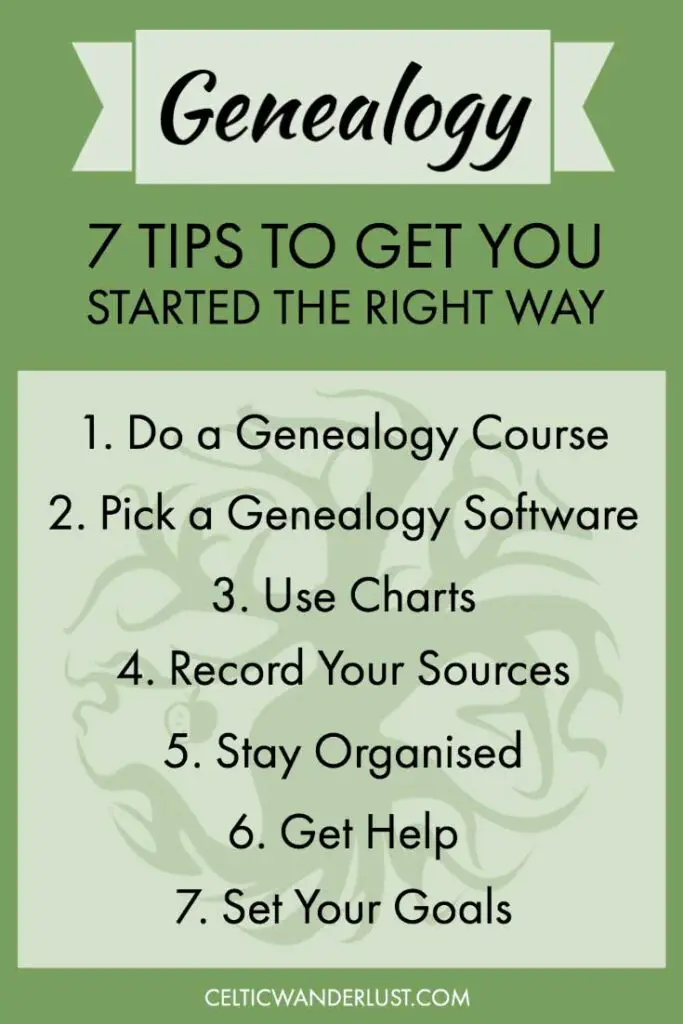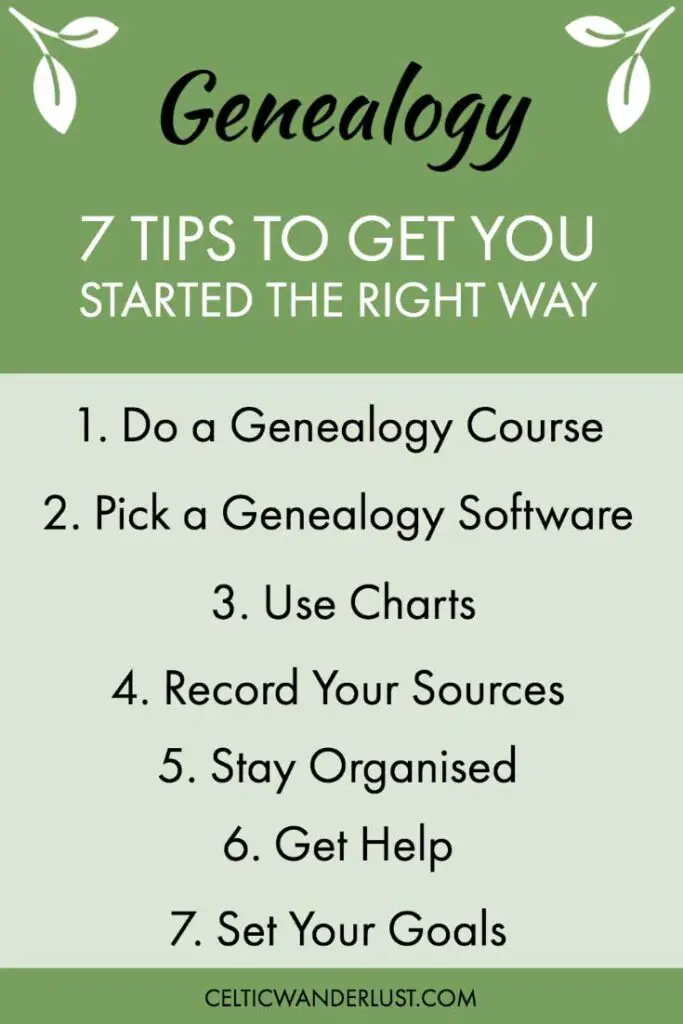New to Genealogy? 7 Tips to Get You Started The Right Way
When I started my own genealogy research, I opened my laptop and dived straight into census records and any historical documents available online. Like a detective, finding bits and pieces of information about my family was thrilling.
However, I quickly felt overwhelmed. I didn’t know which lead to follow, I had too much information to keep track of, and brick walls were fast emerging. The fun was starting to wear off.
I took a break from my research as I was clearly doing something wrong. My methodology was all over the place and needed to be fixed before I could resume my research in the right state of mind.
Instead I spent some time learning about genealogy itself and the best ways to go about researching my family tree. Let me share with you the tips to get you started the right way and make the most of your research.


Do a Genealogy Course
Don’t panic. I’m not talking about enrolling in a Master’s Degree in Family History, unless you found your true calling in Genealogy. Having said that, doing a course in genealogy really opened my eyes to the proper rules and methods of genealogy research.
A course for beginners in genealogy will provide you with enough information to put you on the right track. It is a great starting point to learn about the main sources available to you, pedigree charts and genealogy softwares, why and how to record your sources and how to keep your research organised.
Genealogy courses can be expensive and even though you have a real interest in the subject, you might not be willing to spend a lot of money on your hobby. That’s why I went online. You can find free or cheap genealogy courses on the internet.
The very first course I did was Genealogy: Researching Your Family Tree, a free, 6-week course offered by the reputable University of Strathclyde in Glasgow, UK. You’ll find it on the Futurelearn platform. Another online course I recommend is the Genealogy Diploma Course from the Centre of Excellence website. While it is not free, the course is affordable and you can complete the 11 modules at your own pace.
Pick a Genealogy Software
You don’t need a genealogy program to conduct your research if you prefer to stick with paper charts and notebooks. However I wish I had known about genealogy software right from the beginning of my research.
A genealogy program allows you to gather all your information in one place, including photographs and notes from your research. It makes it easy to update and correct details about your ancestors as you go along and make discoveries. Most of all you can visualise your findings by generating reports and charts whenever you need, and share your family tree in print or electronically.
If you worry about privacy (especially for family members still alive), a genealogy program doesn’t store your family tree on the Internet as genealogy websites do. Instead your family information is safely stored on your own computer.
There is quite a lot of family tree software out there and you’ll need to do your own research to decide which one best suits your needs. For example, some programs have both paid and limited free versions, while some are only available on either Windows or macOS.
I decided to use Gramps. As an open source software, it is completely free to use. The software is supported by a community of volunteers and was updated in 2020, a sign that the program is being carefully looked after. In contrast, a paid software could be discontinued at any time by the company that owes it.
Use Charts to Record Your Research
If you choose paper over software (you are free to do both), there are charts that you need to print out to help you record your findings. These charts are standard practice in genealogy and can be easily found on the internet for free.
Pedigree Charts
A pedigree chart is the schematic representation of your family tree. The ascendant pedigree chart is most often used. It will start with you (or any family member you choose as the starting point of your research) at the bottom. It will then have two branches for your parents, four for your grandparents and so on as you move backward through time.
On these charts you will find spaces to record their names, birth, marriage, death, dates and places. Pedigree charts commonly feature between five and seven generations but you can find charts featuring up to fifteen generations if you ever need to.
Family Group Sheets
A family group sheet is another chart which will help you keep your research organised. While a pedigree chart records your ancestors in direct line, a family group sheet is a worksheet used to record your extended family.
You will need one sheet per family unit. One group sheet usually records the dates and places of birth, marriage, death and burial of the husband, his wife and children. You can sometimes even record the children’s spouses and their grandparents on the same sheet.
Record Your Sources
Keeping track of your sources is the trickiest part of genealogy research but also a task that cannot be overlooked. As you progress into your research, you will find the increasing need to cross-check information to make sure you found the right person for your family tree.
If you don’t record where you find a piece of information the first time around, you might have to dig it up again later, wasting time and energy.
How to record your sources? Some basic elements need to be included on your sheet to make sure you can easily retrieve the evidence later on. These are the title, author or listed person, date, publisher and location. When searching through genealogy websites, recording the detailed web page address on which you find information will save you from future frustration.
Keep Your Findings Organised
Whether you keep a digital version of your findings or prefer to have everything printed out on paper (or both), you need to keep your evidence organised from the get go. As your research progresses, census records, certificates, photographs and other newspaper clippings will accumulate. Finding a way to keep them organised will save you a lot of time.
Create Folders on Your Computer
If you keep your findings on your computer, you will need to come up with a folder structure that makes it easy to search for a note, a photograph or any documents you saved on your hard drive. There is no right way to do it, as long as it works for you.
You can for instance create a folder for each family tree you’re working on. Create subfolders for each generation starting with yourself, then your parents, your paternal and maternal grandparents and so on. For uncles and aunts, create subfolders under your grandparents’ folders and subfolders for your cousins under your uncle or aunt’s folder.
But remember, the research you saved on your computer is never 100% safe. A virus, a hardware failure and it can all be gone. To avoid this misadventure, don’t forget to back up your data! There are different ways to do it. You can save a copy of your files on a USB drive (don’t lose it though!), the cloud or an external hard drive.
Manual Filing
For those keeping a paper version of their charts and documents, folders with dividers are a must-have. Maybe you have a dedicated cabinet or a box with suspension files? That’s even better!
No matter how you do it, the goal is to stay organised and efficient. You want to avoid wasting time looking for a piece of evidence you know you have… somewhere!
Know Where To Find Help
Genealogy research can be a lonely affair at times and you might feel the need to get some support or expertise. There are people out there with the same interest in genealogy who will be very happy to help you out with your research. Don’t be afraid to reach out.
Facebook Groups
You’ll find groups built around genealogy on Facebook. They are usually organised around a country or a specific region in the world and open to everyone with an interest in genealogy.
These groups are a great place to ask questions about your family tree, especially if you hit a brick wall. You can’t seem to be able to decipher a census record? Ask around! Someone with more experience might be able to help you out.
If you have questions about your Scottish ancestors for example, why not join Scottish Genealogy, a very active group with more than 17 000 members. Impressive!
Local Library, Genealogy and History Associations
Local libraries can provide you with a wealth of information with sometimes sections dedicated to genealogy and local family history. Some even maintain their own records. Others can offer free genealogy services like the National Library of Ireland in Dublin. During weekdays experienced researchers are available for your questions.
You might want to join your local Genealogy or History Association. They might have a well documented library that you could use for your research. More importantly, you’ll meet people with the same interest who could offer their expertise.
Set Your Goals
The main pitfall when beginning your genealogy research is to fall down the rabbit hole. You’ll want to search at once for every ancestor you’ve heard about but soon enough you’ll feel overwhelmed and realise that you’re not going anywhere. To be productive in your research, you need to set a goal and keep your eyes on it.
It is your own family tree, so you get to decide where to start. Maybe you heard stories about your grandparents emigrating from Ireland on your father’s side. Or you want to investigate your mother’s French maiden name. If you encounter other branches of your family along the way, make a note of it. Don’t deviate from your goal. You can always investigate these branches further at a later time.
Genealogy should be fun. And to keep it that way a few rules need to be followed from the very beginning. I learned it the hard way. With these few tips, I hope your research will be made easier so you can enjoy the process and discover more about your family history.
RELATED POSTS


Leave a Reply